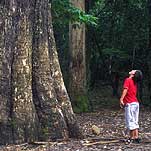80% of the monumental trees in Spain at the turn of the 20th century no longer exist.
The tallest tree in Spain grows on the banks of the river Landro in a forest in Lugo. It is 67 metres tall with a girth of 10.5m, and is known as ' El Abuelo de Chavín' . The 'abuelo' (grandfather) is a eucalyptus (eucalyptus globus), the bane of autonomous Spanish forests and a major culprit in the propagation of fires. It is surrounded by other majestic examples. Some say they were planted to contain flooding, others say they were an experiment.
 El Abuelo de Chavín El Abuelo de Chavín
TVE video on monumental trees in Spain. Click on play
Nobody really knows where the oldest tree in the Peninsula is, but one candidate is Lo Parot , a venerable olive with a girth of 9 metres growing in Horta de San Juan in Tarragona. Olive tree age is often exaggerated though Lo Parot in Horta de Sant Joan in Tarragona is certainly between 1,000-1,500 years old. It would have been planted during Visigoth or Arab times.
 lo parot (from this site) lo parot (from this site)
Locals from the village of Zarza de Montánchez in Caceres have always known and loved La Terrona , perhaps the oldest and biggest of that most Spanish of trees; the holm oak* (encina - quercus ilex ). It took a bolt of lightning to bring it to the attention of the outside world. The lightning split the tree in two and almost killed it. Biologists came to the rescue and discovered that the tree is perhaps the oldest and biggest holm oak in the country: it's 16.5m tall, with a girth of 7.8m and is 800 years old. The village's ex-mayor claims they used to be an even bigger one: La Governadora, but it was burnt after also being hit by lightning 27 years ago. Although the biologists may have saved the venerable old tree from a natural death, its newly-found fame has brought new dangers, as unscrupulous tourists are causing serious damage.
Notes
*The holm oak is an essential, almost defining, element of the Spanish Mediterranean landscape. It has been said that the tree was until recently as important to the Spanish peasant as the seal was to Eskimos. Hyperbole apart, the encina was certainly a cornerstone of traditional culture. Antonio Machado, the 20th-century Spanish poet put the importance of the tree in these terms (my clumsy translation):
"El campo mismo se hizo árbol en tí, parda encina"
"The land (1) became a tree in you, brown oak (2) "
"The land (1) grew up tree in you, brown oak (2) "
(1) countryside sounds far to tame a thing to describe the landscape Machado was talking about. Countryside translates better as campiña, which is restricted in Spain to small areas like L'Ampordà in northern Catalonia, described by the Catalan poet Josep Plà as a 'middle-class landscape'.
'Country' alone I felt would be ambiguous.
(2) maybe brown encina would sound better. 'brown holm oak' sounds too technical, better to say 'brown quercus and totally ruin it.
It is believed to be the climax species of the true Mediterranean forest, which once stretched over great swathes of Spain. This virgin forest has long-since disappeared through grazing, charcoal-burning and felling. A few patches of something approaching this vast primeval forest survive on isolated higher slopes and particularly in the Sierra de Guara on the edge of the Aragonese Pyrenees. Many of these forests grew on poor and arid soils, and when felled these could not support agriculture for long and were soon abandoned to be taken over by maquis and garrigue, which covers much of Spain and the Mediterranean in general today. However, elsewhere in Spain and parts of the Maghreb, instead being felled, huge forests of holm oak were thinned out, creating the sparse pasture parkland known as dehesa , which together with evergreen cork form a unique man-made, managed and bio-diverse ecosystem.
Quercus Ilex is considered to be two separate species:
1. western holm oak (ssp. Ballota - yes that's Ballota not Bellota, known in Spanish as encina or carrasca ), the classic sweet-acorn producing oak of the south-western and central dehesas, and also present in Morocco and France;
2. the holm oak 'proper' (ssp. Ilex ) which is more prevalent in northern Spain from Asturias to Catalonia, and the rest of the Mediterranean.
|
 El Abuelo de Chavín
El Abuelo de Chavín
 lo parot (
lo parot (